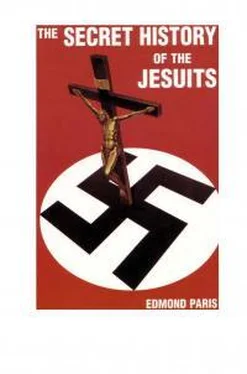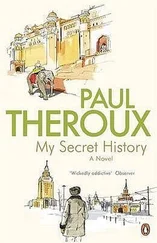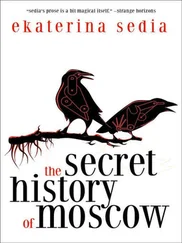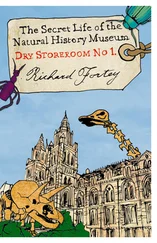with his family which received him as a friend. "Birds of a feather flock together".
So, the most sincere cordiality always reigned in the relations between the assassins and ecclesiastics—of course, many of these ecclesiastics held both positions, for which they were never blamed. "The end justifies the means".
When Pavelitch and his 4,000 "Oustachis"—which included archbishop Saric, a Jesuit, bishop Garic and 400 clerics—left the scene of their exploits to go first to Austria then on to Italy, they left behind part of their
"treasures": films, photographs, recorded speeches of Ante Pavelitch, chests full of jewels, gold coins, gold and platinum from the teeth, bracelets, wedding rings and pieces of dentures made of gold and platinum.
This spoil taken from the poor wretches who had been murdered were hidden at the Archiepiscopal palace where they were eventually found.
As for the fugitives, they took advantage of the "Pontifical Commission for Assistance", created expressly to save war criminals. This charitable institution hid them in convents, mainly in Austria and Italy, and provided the chiefs with false passports which enabled them to go to "friendly" countries, where they would be able to enjoy the fruits of their robberies in peace. This was done for Ante Pavelitch, whose presence in Argentina was revealed, in 1957, through an attempt upon his life in which he was wounded.
Since then, the dictatorial regime collapsed in Buenos Aires. Like former president Peron himself, his protege had to leave Argentina. From Paraguay where he went first, he reached Spain where he died on the 28th (89) In Monseigneur Stepinac's own diocese, Kamensko, 400 came back to the Roman Catholic fold in one day. On the 12th of June 1942, "Radio Vatican" announced these mass-conversions, stating that it had been "spontaneous and without any pressure on the part of civil and ecclesiastical authorities".
GERMAN AGGRESSIONS AND THE JESUITS
149
of December 1959, at the German hospital of Madrid. On that occasion, the French press recalled his bloody career and—more discreetly the
"powerful accomplices" who enabled him to escape punishment.
Under the title "Belgrade demanded his extradition in vain", we read in "Le Monde": "The brief information published in the press this morning revived, amongst the Yugoslav people, souvenirs of a past filled with sufferings and bitterness towards those who, by hiding Ante Pavelitch, for n e a r l y fifteen years, obstructed the course of justice".(90) "Paris-Presse" points out the last shelter offered to the terrorist with this short, but significant phrase: "He ended up in a Franciscan monastery of Madrid".(91)
It is from there, in fact, that Pavelitch was taken to hospital where he paid his debt to nature—but not to justice, scoffed at by these "powerful accomplices" who are easy to identify.
Monseigneur Stepinac who had, as he said, a "clear conscience", stayed in Zagreb where he was tried in 1946. Condemned to hard labour, he was in fact only made to reside in his native village. The penance was easy to bear, as we can see, but the Church needs martyrs. The archbishop of Zagreb was then made a member of the holy cohort, in his lifetime, by Pius XII who hastened to confer on him the title of "Cardinal", in recognition of "his apostolate which displays the purest brightness".
We are acquainted with the symbolic meaning of the Cardinals' Purple: the one who dons it must be ready to confess his Faith "usque ad sanguinis effusionem": to the point of shedding blood. We cannot deny that this shedding was abundant in Croatia, during the apostolate of this holy man, but the blood which flowed there in torrents was not the prelate's: it was the blood of Orthodox believers and Jews. Must we see there a "reversibility of merits."
If that is the case, the right to cardinalship of Monseigneur Stepinac cannot be contested. In the diocese of Gornji Karlovac, part of his archbishopric, out of 460,000 Orthodox people who lived there, 50,000
were able to hide in the mountains, 50,000 were sent to Serbia, 40,000 were converted to Catholicism through the regime of terror and 280,000 were massacred".(92)
On the 19th of December 1958, we read in "Catholic France": "To exalt the greatness and heroism of His Eminence the Cardinal Stepinac, a great meeting will take place on the 21st of December 1958, at 4 o'clock, in the crypt of Sainte-Odile, 2, Avenue Stephane-Mallarme, Paris 17. It will be presided over by His Eminence the Cardinal Feltin, archbishop of Paris.
(90) "Le Monde", 31st of December 1959.
(91) "Paris-Presse", 31st of December 1959.
( 9 2 ) Cf. Jean Hussard: "Vu en Yougoslavie" (Lausanne 1947, p.216).
150
THE SECRET HISTORY OF THE JESUITS
Senator Ernest Pezet and the Reverend Father Dragoun, national rector of the Croatian Mission in France, will take part. His Excellency Monseigneur Rupp will celebrate mass and communion".
This is how a new figure, and not one of the least important, the one of Cardinal Stepinac, came to enrich the gallery of Great Jesuits.
Another aim of this meeting on the 21st of December 1958, in the crypt of Sainte-Odile, was to "launch" a book written in the defense of Zagreb's archbishop, by the R.P. Dragoun himself; Monseigneur Rupp, coadjutor of Cardinal Feltin, wrote the foreword. We cannot give here a full analysis but will say this:
The book is entitled "The Dossier of Cardinal Stepinac", which seems to promise the reader an objective exposition of the trial at Zagreb. In fact, in this volume which numbers 285 pages, we find the speeches of the archbishop's two counsels in full, accompanied by extensive remarks from the author, but, neither the charge itself, nor the speech for the prosecution are mentioned, even briefly.
The R.P. Dragoun seems to ignore the French proverb "Qui n'entend qu'une cloche n'entend qu'un son" (there are two sides to every story)-unless, of course, he knows it too well!
Be that as it may, this systematic obliteration of the opposite side of the story would be enough to close the debate.
Let us consider, though, the good reasons invoked for the discharge of Zagreb's archbishop. But first of all, this question: Was Monseigneur Stepinac really the metropolitan of Croatia and Slovenia? The book of the R.P. Dragoun does not answer this question. On page 142 of that book, we read this concerning the copy of a report by Monseigneur Stepinac, the authenticity of which was contested by the defence:
"In the text of the copy, the archbishop is described as "Metropolitan Croatiae et Slavoniae", but the archbishop is not a metropolitan and never presented himself as such.
This would clear the matter up if we didn't read, on page 114, the following taken from Monseigneur Stepinac's own declarations before the tribunal:
"The Holy See often emphasized that the small nations and the national minorities have the right to be free. Should not I, as "bishop and metropolitan", have the right to discuss it?" The more we read, the less we understand!
No matter! As we are reminded again and again, Monseigneur Stepinac could not influence in any way the behaviour of his flock and clergy. The To those who bring out the articles of the Catholic press praising the accomplishments of Pavelitch and his hired assassins, the answer is: "It is simply ridiculous to make Monseigneur Stepinac responsible for what the newspaper wrote".
GERMAN AGGRESSIONS AND THE JESUITS
1 51
Even when this paper was the "Katolicki List", the most important Catholic publication in Zagreb, diocese of Monseigneur Stepinac! In those conditions, we won't bother mentioning the "Andjeo Cuvar" (The Guardian Angel) belonging to the Franciscans, the "Glasnik Sv. Ante" (The Voice of Saint-Anthony) to the conventuals of the "Katolicki Tjednik", (The Catholic Weekly) of Sarajevo, bishop Saritch, nor, of course, the "Vjesnik Pocasne Straze Srca Isusova" (The Publication of the Guard of Honour of the Heart of Jesus(!), belonging to the Jesuits).
Читать дальше












